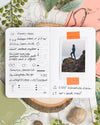
Hiking is an adventure that beckons the spirit of both the casual wanderer and the seasoned trekker alike. It's a gateway to experiencing the raw beauty of nature, from serene forest walks to challenging mountain ascents.
Yet, the difference between a rewarding hike and a challenging one might boil down to how prepared you really are. Whether going on a light day hike or venturing into the more demanding backcountry, the right hiking gear is necessary if you plan to safely embrace the serenity that nature has to offer.
Let us discuss the eight essential items every hiker should include in their packing list, promising an enjoyable and safe journey. From sun protection to hydration and navigation tools to emergency gear, we'll guide you through the essentials.
The best hiking shoes, tips on managing hydration on hot days, and how to prepare for the unexpected with a well-stocked first aid kit are on the horizon!
1. Navigation and Communication Tools
Having reliable navigation tools is non-negotiable in the vast openness of the wilderness, where trails twist and turn through diverse terrains. A physical map and compass have long been the stalwarts of outdoor navigation, unaffected by battery life or signal strength.
However, in the modern hiking scene, a GPS device offers a high-tech complement, providing pinpoint accuracy and route tracking even in the most remote areas. Apps and digital maps can enhance your navigation toolkit, offering real-time updates and trail information right at your fingertips. Meanwhile, you can log your experience with a hike passport, blending the analog with the digital.
The lesson here is clear: Equipping yourself with the right tools to guide your path ensures safer hiking trips.
2. Sun Protection and Hydration
Under the sunny sky, protecting your skin and eyes is oh-so-important. Sun protection on hikes extends beyond simply applying sunscreen — grab a range of gear designed to shield you from those pesky UV rays.
While broad-spectrum sunscreen with a high SPF is a must, don't stop there. Use a long-sleeve base layer of moisture-wicking fabric to cover your skin without causing you to sweat.
Hydration is equally important. The exertion of hiking, especially under the sun, can quickly lead to dehydration. Carrying a water bottle or a hydration pack gives you a simple yet constant water supply.
For longer hikes, noting your water sources along the trail and carrying a portable water filter or purification tablets can make natural water safe to drink, protecting you from any germs you’d rather not enter your body.
3. Footwear and Clothing
Let’s get back to the basics — the foundation of a good hike often starts with what's on your feet. Choosing the right hiking shoes or hiking boots is imperative when you hit the trail. No one wants to be uncomfortable when connecting with the beauty of nature on a sunny day.
Shoes with good ankle support, aggressive tread for traction, and waterproof features are ideal for most hikers. For those prone to blisters, moisture-wicking wool socks can encourage extra comfort and fight off blisters.
The mantra for hiking clothing: Layering is best. As mentioned earlier, start with a moisture-wicking base layer to keep sweat away from your skin, add an insulating mid-layer for warmth, and finish with a waterproof and breathable outer layer to protect against wind and rain.
4. Food and Energy Supplies
No hike is complete without snacks! The demanding nature of hiking increases your body's need for calories and nutrients, making it essential to carry high-energy, nutritious snacks. Not a bad necessity, right?
Energy bars, trail mix, dried fruit, and nuts are ideal for on-the-go snacking. They’ll give you a quick burst of energy and some helpful (and tasty) nutrients. And don’t worry, these options are lightweight and easy to pack. You might want to add sandwiches, hard-boiled eggs, or even energy gels to your food stash for long hikes.
Beyond the basics, it's important to carry a little extra food than you might anticipate needing. This extra stash can be a lifesaver in situations where you find yourself hitting the trails a little longer than planned. Because, let’s be honest, we all get a little lost sometimes!
By choosing the right snacks that’ll keep your energy levels high, you can maintain good spirits and just enough energy, making your hiking experience both enjoyable and sustainable.
5. Safety and Emergency Gear
A well-prepared hiker is one who carries the safety and emergency gear. The wilderness? Unpredictable, to say the least!
A basic first aid kit is non-negotiable — these are designed to lend a helping hand with minor injuries, blisters, and other common ailments when hitting the trails. You can also try customizing your kit to include personal medications and any other items that are unique to your own needs.
Some other essential safety items might include a fire starter (waterproof matches, lighter, or a flint striker) and a whistle, just in case you need to signal help. In regions where wildlife sightings are common, carrying bear spray (and knowing how to use it!) can deter a potentially angry animal. Who wouldn’t want that extra layer of security?
Additionally, an emergency blanket or space blanket can be a lifesaver, offering warmth and protection in a compact, lightweight form.
And let’s take safety a little further: Always inform someone of your hiking plan and expected return time. If you don’t return around your planned time, this can alert them that you might need some help. If you’re a planner (like us!), a campground passport can be a handy tool for tracking inventory and preparing in full.
6. Repair Kits and Utility Tools
The sometimes unpredictable nature of hiking may call for gear repair. A compact repair kit, including duct tape, spare parts for your gear (like buckles or cordage), and a sewing kit, can cover some ground — mending a torn backpack, fixing broken straps, or patching up a hole in your tent to name a few.
A multi-tool can also be your best hiking buddy. They typically have functionalities ranging from scissors and screwdrivers to knives and can openers — a good multi-tool can assist in gear repair, food preparation, and even in situations that call for first aid. A sturdy pocket knife may also be a handy asset, offering a simple, reliable way to perform the simplest (or most complicated) of tasks.
Try empowering yourself by carrying the best hiking tools with you. Tackle those unexpected repairs and challenges, ensuring your hike can continue smoothly, even if you have a minor setback or two!
7. Additional Essentials for Comfort and Hygiene
Comfort and hygiene are a must for your health and safety. Carrying toilet paper and a small trowel for digging a cat hole is important for keeping our surroundings clean and free of waste, aligning with the “leave no trace” principles. Hand sanitizer is another essential you might want to grab on your way out the door. It’ll keep your hands squeaky clean after taking a quick bathroom break or before chowing down on one of your nutritious snacks on the trails.
For hikes in buggy areas, insect repellent will be your best friend. It can provide quite a bit of relief and protection from mosquito and tick bites. They can carry diseases, so better safe than sorry!
On sunny days, try bringing an additional tube of sunscreen. More sun means more warmth, and you might sweat off a layer of sunscreen or two and need to reapply. And when the sun hides behind a tree or fades into the horizon, a headlamp or flashlight is a wise addition to your pack. Yes, even during a day hike. It ensures you're not caught off guard by a not-so-planned delay in your return time.
With these additional must-haves, you ensure a level of preparedness that contributes to your physical comfort and overall trail enjoyment.
The Prepared Hiker's Journey
Whether you're setting out for a serene day hike or bracing for the rugged nature of the backcountry, the key to a successful adventure lies in a well-thought-out pack. The goal is to relish every step and every moment of connection with the natural world.
As you gear up for your next hike, consider this guide as a foundation for personalizing your pack based on the specific demands of your chosen trail and the unique elements of your own experience.
And why not log all of your adventurous, nature-filled moments? Check out our national park passport. Don’t let the memories fade away!
Sources:
First Aid | Appalachian Trail Conservancy
Hike Smart | National Park Service
Safety Essentials: A Toolkit for Hikers | Washington Trails Association








